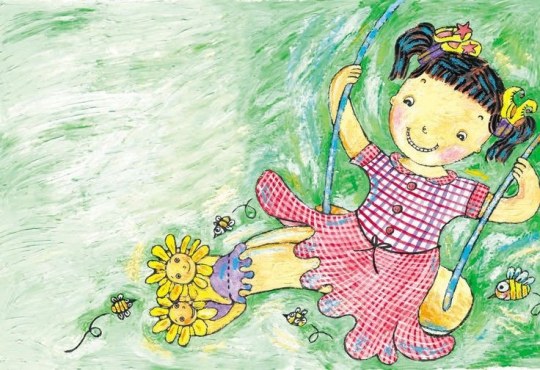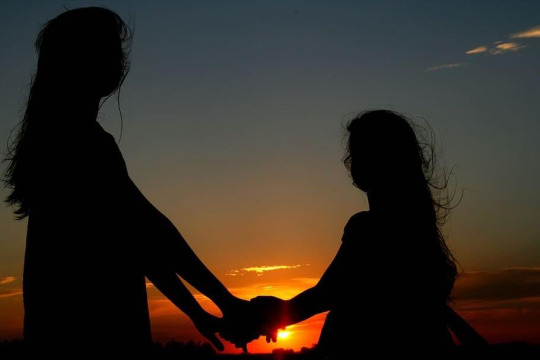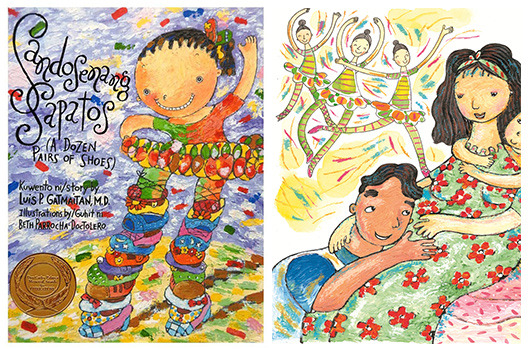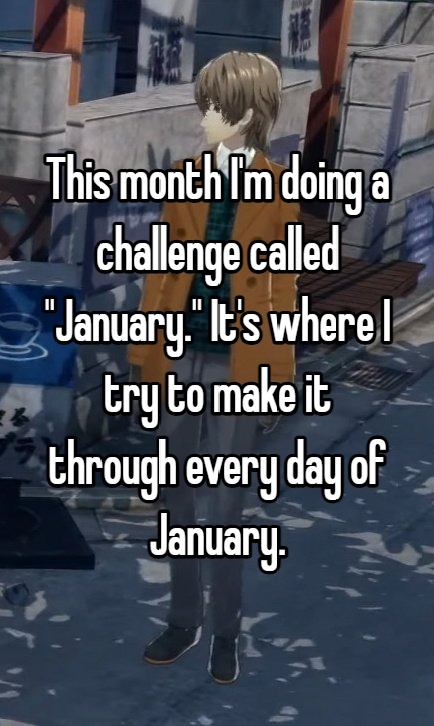#psychological approach
Explore tagged Tumblr posts
Text
Heart and Sole: A Tri-Theory Literary Critique of Gatmaitan's Sandosenang Sapatos
Written by: Delos Santos, Cindy Etom, Airah Clare Nufable, Cleshen Panal, Mark Jade Pido, Zyron Sabado, Clark Ivan Santos, Hannah Levee
“Alay ko ang kuwentong ito sa lahat ng batang kinapos ng damdamin at kaluluwa, at sa kanilang nagkulang ng isang kamay, isang paa, isang daliri, isang mata. [I dedicate this story to all of the children who are lacking in feeling and soul, and to those who are missing a hand, a foot, a finger, and an eye.]” — Luis P. Gatmaitan, M.D.

In Gatmaitan's poignant narrative, "Sandosenang Sapatos," the readers are introduced to the world of a character called “Tatay”, a skilled shoemaker renowned in their town for crafting exquisite footwear. The story revolves around the central character, Karina, Tatay's daughter, who grows up surrounded by the intricacies of her father's craft. In this literary critique, the readers will explore the narrative through the lenses of Formalism, Psychological, and Biographical theories, in order to unravel the layers of symbolism, character motivations, and the profound influence of the author's own experiences on the story itself.
Formalism involved scrutinizing the story's structure, language, and stylistic choices. Gatmaitan's portrayal of Tatay's craftsmanship, the vivid descriptions of the shoes, and the recurring motif of footwear become essential elements to explore. On the other hand, through the lens of Psychological theory, the readers analyze the characters' inner workings and motivations. The emotional journey of the characters, especially Susie, Karina's sister who was born without feet, opens avenues to understand the psychological impact of physical differences and the resilience of the human spirit.
Meanwhile, Biographical theory provides a unique perspective as we consider Gatmaitan's own background and experiences. The author, who is also a pediatrician, infuses the narrative with themes of love, acceptance, and the complexities of parenthood. The biographical lens offers insights into how Gatmaitan's professional expertise and personal encounters may have shaped the portrayal of medical challenges and familial bonds within the story.
Through these three lenses, the readers aim to unravel the complexities of "Sandosenang Sapatos," examining not only its formal elements and psychological depth, but also understanding the impact of Gatmaitan's own life experiences on the creation of this heartfelt short story.


First, for the formalistic approach, the short story used the first person as its point of view. It utilized the pronouns “ako [I]”, “ akin [my]”, and “kami [we]” throughout the story. With these pronouns, the readers analyzed that the story was written based on the character’s perspective, which is Karina. Along with this, as the story progresses, the readers observe that the events are based on her experiences with her classmates, other people, and mainly, her family.
For the setting, the story is situated in a town where Karina and her family live. Their home symbolizes love and strength, showing how they support each other despite the challenges. Through the setting, the story explores the contrast between dreams and reality, particularly through Susie's dreams of beautiful shoes and the harsh realities of her disability. The setting not only provides a backdrop but also deeply influences the emotional atmosphere, allowing the readers to empathize with the characters journey of love, loss, and acceptance within their family and community.
For the structure, it is characterized by its plot, set in a town where the characters are introduced. As the plot develops, the readers can gain insights on what is happening in the family and the significance of the shoes as a symbol in the story through the first-point of view of the narrator. The narrator's viewpoint focuses on her interactions with her father and sister, Susie, providing readers with a deeper understanding of the events unfolding within the family. Additionally, symbolism is woven into the narrative, with shoes representing various themes, including identity, hope, and the bond between family members. Also, the setting provides context for the events that unfold, including societal judgment and the challenges faced by Susie's disability. Through its structure, the story effectively conveys its themes and messages, highlighting the importance of unconditional love and acceptance within a family amidst life's trials and tribulations.
For the characters, it involves Karina, her father, her mother, and Susie. Karina, who is the main character and the one who is narrating the story, is a loving daughter and sister. She is willing to do anything to make her family happy, especially her father. She is willing to go beyond her limits just to fulfill her father's dream. This is evident in the part of the story when Susie was born with deformities, and now cannot fulfill her father's dream for her to become a ballerina. Now as a loving daughter, even if she did not like ballet, she still decided to persuade her mother to enroll her in a ballet school. Moreover, Karina is a loving sister. Despite Susie's deformities, she did not treat her differently. She is willing to adjust and stand up for her. She became her wheelchair assistant and defender against her bullies. Furthermore, Susie’s condition never became a hindrance for them to make a strong bond. They found a lot of games that did not require the use of feet. With Karina’s statement, which is “Lagi nga niya akong tinatalo sa sungka, jackstone, scrabble, at pitik-bulag. [She always beats me in sungka, jackstone, scrabble, and pitik-bulag.]”, the readers understood that they really have a good relationship with each other.
In addition, Karina’s father, a supporting character, is a skillful shoemaker. He is well-known in their town for making creative, durable, and excellent shoes. It can be supported with Karina’s statement, which is “Ayon sa mga sabi-sabi, tatalunin pa raw ng mga sapatos ni Tatay ang mga sapatos na gawang-Marikina. [From what we heard, my father’s shoes were so much better than the shoes made in Marikina.]”. Tatay is also a loving father. Aside from the fact that he always made shoes for Karina on different occasions, he showed his love for his family in many ways. He is always willing to protect them from other people, especially when Susie got bullied by a guy when they went on a picnic. He even told Susie one bed time that he and her mother will always love her even if she had no feet. Most importantly, his love is unconditional. Knowing Susie’s condition, he still made shoes for her even if he knows that Susie cannot wear these. With his love and talent for shoemaking, he also wants Susie to be part of what he always does by making her beautiful shoes.
Karina’s mother, who is also a supporting character, is a loving mother. Same with her father, she is willing to keep her family from harm and did not treat Susie differently. The last character, who is Susie, is Karina’s little sister. Even if it is not her perspective, she is also considered as a main character since the story mainly revolves around her. Susie is born with deformities, in which she had no feet. However, her family showered her with the love she needed, and even more. Her family always makes her feel that she is very special and there is nothing wrong with her.
Each character has a significance in the story since each of them contributes to it as a whole. For the plot, the story introduces Karina’s father as a famous shoemaker in their town. His father made her many exceptional shoes for every occasion such as Christmas, birthdays, school openings. Now as the story goes on, it introduces her mother who got pregnant when she was in second grade. After her little sister, Susie, was born, they found out that she had deformities. This marks the beginning of the conflict, as her father's dream for Susie, to become a ballerina, crashes. To sum all things, each character really has a crucial role that makes the story as a whole.
Furthermore, the use of imagery is present in the story. It is highly evident when Karina described the shoes that her father made for Susie. She used the description such as “dilaw na tsarol na may dekorasyong sunflower sa harap [yellow patent leather shoes with sunflower upfront]”, “kulay pulang velvet na may malaking buckle sa tagiliran [red velvet shoes with a big side buckle]”, “asul na sapatos na bukas ang dulo at litaw ang mga daliri [blue open-toed shoes with her own toes peeking through]”, and many more. With this, while the readers were reading the story, the words used by Karina helped them to have an image painted in their minds on what the shoes would look like. Moreover, imagery is also used when Karina and her family went to the park for a picnic, and encountered a guy that criticized Susie for her condition. With the statement “Biglang namula si Tatay sa mga narinig. Tumikom ang mga kamao. [My father turned red. He clenched his fist.]”, the readers can visualize her father’s face in that situation. Through this imagery, the readers can imagine how mad he was with the guy that insulted his daughter.
In summary, "Sandosenang Sapatos" employs a formalistic lens that brings out the narrative's core. The use of first-person perspective, with pronouns like "ako" and "akin," roots the story in Karina's viewpoint, highlighting her experiences with family and the town. The setting, portraying a town marked by love and resilience, contrasts dreams and realities, notably Susie's aspirations against the challenges of her disability. The plot unfolds dynamically, shedding light on family dynamics and the symbolic role of shoes. Characters, from Karina's devotion to her father's shoemaking and Susie's resilience, play essential roles. Imagery, especially in describing Susie's shoes and intense moments, offers a visual connection for readers. "Sandosenang Sapatos" is a straightforward exploration of love, identity, and acceptance, prompting readers to engage with the emotional aspects within family and societal contexts.


Second, looking at the text using a psychological lens imparted to the readers what may be going through the characters' minds as the story progresses, especially the turmoil created by physical differences, and how familial love and the indomitable human will rise above these difficulties.
The characterization of Tatay in the story, particularly his passion for shoemaking and love of family, is a recurring theme, despite people insulting his daughter Susie as seen in the line “Tingnan n’yo o, puwedeng pang-karnabal ‘yung bata!”, or being the topic of gossip, as people try to create fantastical and unbelievable reasons why Susie was born without feet, he continues to create shoes for her regardless, showing his motivation to provide and care for his family, and his motivation to push through struggles in life.
Karina also follows the same thread, and this can be shown through her self-sacrifice, wanting to learn ballet to fulfill the dreams of her father, playing with her sister through games that do not need feet, defending her from bullies, pushing her wheelchair, and generally assisting her. Her dedication and grit once again triumphs over difficulties.
Nanay’s character also shows resilience and love all in the midst of all the adversity. “Nagkaroon kasi ako ng impeksyon anak.” Her inability to stop Susie's illness causes her to feel guilty and sad. She also experiences psychological effects from the gossip and judgment from society over Susie's condition, including a strong desire to protect her daughter from harm and protective instincts.
Susie is portrayed as a strong, creative person who finds comfort and happiness in her aspirations and goals. Susie's fantasies about these intricate and exquisite shoes show the psychological effects of growing up with a physical impairment. She may be using these dreams as a coping method, escaping the confines of her physical reality and finding solace in an idealized version of herself with a perfect pair of feet.
The recurring theme of Susie's dreams about shoes also indicate a longing for a sense of normalcy and the desire to experience activities she might not be able to in reality, such as wearing the ballet shoes her father wants her to have. Her ability to find joy in small moments, and her creative imagination are notable aspects of her character that reflected these coping strategies that yielded her to have a positive outlook in life.
The psychological lens reveals in the narrative the struggle, coping strategies, resilience and love of the characters. Tatay with his undying determination of making shoes for Susie despite her complications, Karina sacrificing her own ideals just to make his father’s wish come true, Nanay grapples with the emotional weight of Susie's condition and societal judgments, while Susie uses her dreams and imagination as a means of navigating and finding happiness in a world that sometimes fails to understand her.


Finally, the readers analyze the short story through the third and last literary theory lens, which is the Biographical Lens. This lens unveils a deeper layer of understanding as the readers examine the author's life, experiences, and personal context. This lens allows proper analysis of how the author's unique background and journey may have influenced the narrative, characters, and thematic elements within the short story. In this case, the readers explore the life of Dr. Luis P. Gatmaitan, the Filipino author of “Sandosenang Sapatos”.
Luis P. Gatmaitan, M.D., widely known as “Tito Dok” to his readers, has written more than 40 children’s books. Aside from being a Filipino children’s author, Tito Dok is also an accomplished medical doctor specializing in pediatrics. Currently, he chairs the Philippine Board on Books for Young People (PBBY), and is part of the National Council for Children’s Television (NCCT) as a child development specialist (Monde, 2022). Both of these positions are highly notable, as they serve as evidence for Tito Dok’s passion for pediatric healthcare and literary education.
Most of Tito Dok’s books contain themes that revolve around differently-abled people, senility, adoption, coping with death, coping with cancer, childhood diseases, and children’s rights. One of his popular works is “Sandosenang Sapatos” or “A Dozen Pairs of Shoes”. This particular book has won him an award in the 2001 Don Carlos Palanca Memorial Awards for Literature, which are a set of literary awards for Philippine writers. Furthermore, “Sandosenang Sapatos” was named the 2005 Outstanding Book for Young People with Disabilities by the International Board on Books for Young People (IBBY), which showcases the global impact of Tito Dok’s work. Recently, the short story was also featured as a musical play, solidifying its place in the Philippine literary industry.
Tito Dok’s inspiration for writing this short story can be traced back to when he attended a training course in creating non-fiction books for young people in Japan. The author was amazed by how the Japanese people respected those with mobility issues, leading him to have an idea of writing about these kinds of people. One time, he had a patient who was born without feet. Tito Dok then thought, “What if this child was born to a father who worked as a shoemaker?" This then led to the writing of the aforementioned short story.
Tito Dok possesses a wide knowledge of medical information, which was evident in his writing. In his work “Sandosenang Sapatos,” the readers have read the part where Susie’s mother disclosed to her eldest, Karina, that she had German measles while she was carrying Susie, resulting in her youngest daughter to be born without feet. This particular scenario reflects the expertise of the author in the medical field. As a doctor himself, Tito Dok must have studied or witnessed that illnesses during pregnancy, such as German measles, could lead to birth defects (Leonor & Mendez, 2023).
In the short story, despite missing her lower limbs, Susie grew up in a loving and caring family who never treated her less for being differently-abled. The author came up with this particular character trait after observing that “Some children grew up to be physically whole but emotionally disabled, or physically disabled but physically whole”. The author was able to convey this personal message to the readers, instilling hope in others about physically challenged people like the short story’s Susie.

In conclusion, "Sandosenang Sapatos" by Luis P. Gatmaitan is a narrative that explores the concepts of human emotion, resilience, and familial love. The author's dedication, expressed in the heartfelt dedication to children facing physical challenges, sets the tone for a narrative rich in depth and compassion. Through the lenses of Formalism, Psychological theory, and Biographical insights, the readers have unraveled and given an in-depth critique and analysis of the work.
The lens of Formalism unveiled the structure of the story, with a first-person perspective amplifying Karina's experiences, while vivid descriptions of shoes become symbolic threads woven throughout the narrative. Psychological theory invited readers into the minds of characters, exposing their struggles, coping strategies, and unwavering love in the face of adversity. The characters - Karina, Tatay, Nanay, and Susie - each contribute significantly to the plot, portraying a resilient family facing life's trials with unconditional love.
And of course, the Biographical lens adds another layer of understanding, showcasing Dr. Gatmaitan's dual roles as a renowned pediatrician and a prolific children's author. His background in pediatric healthcare is reflected in the narrative's accurate portrayal of medical conditions, emphasizing the author's commitment to educating young minds. The story's origins in Tito Dok's encounter with a patient born without feet add a personal touch, infusing the tale with authenticity and empathy.
"Sandosenang Sapatos" stands as a testament to the power of storytelling to foster understanding, empathy, and hope. Dr. Gatmaitan's masterful blend of literary prowess and medical expertise creates a narrative that resonates beyond its pages, leaving an indelible mark on readers' hearts and minds. Through the holistic combination of formal elements, psychological depths, and biographical influences, the readers gain a comprehensive appreciation for the layers of meaning embedded in this heartfelt short story, celebrating the strength of the human spirit and the enduring bonds of family.
#sandosenangsapatos#literary criticism#literary critique#formalism#psychological approach#biological approach
2 notes
·
View notes
Text
I really wonder if trauma theorists who say things like "Humans are the only animal that will be in a fright state when physically safe" or "the rest of the animal kingdom doesn't get PTSD" have ever, like
Do you think they've actually ever met an animal?
#staranise original#psychology#child abuse tw#ptsd tw#animal cruelty tw#so much of what we know about the nervous system and behaviour comes from animal studies!!!#the physiological toll of even fairly brief upsetting events on baby rats is evident for the rest of their lives#my cat has been spoiled like a princess for a decade straight#and if you reach out to pet the top of her head with your hand palm-down she WILL smack you#no matter how happy she is with the rest of the interaction#she LOVES being petted on the head if you approach with your hand behind her ears#seeing that A L W A Y S causes her to react out of sheer reflex#even with me#tell me that's not a trauma response#actually don't#I need to go wrap presents
3K notes
·
View notes
Text
Jason's approach to Nico is actually SO tactful and empathetic. He is super emotionally and strategically intellectual + he is canonically an expert at reading body language because of lupa + he also observes people a lot, so I'm not surprised.
He called Nico out and told him to stop hiding in the shadows and pushing people away, but simultaneously reassured him that he was willing to be nicos friend. He gave nico a blunt reality check on what he's doing, but wasn't rude about it.
He never told anyone nicos secret, not even his girlfriend, and was very patient with him even after he lashed out. And after their friendship evolved, he was STILL very tactful and sought consent before he hugged Nico. He never forced or guilt tripped nico into staying at camp, and respected his decision if he wanted to leave but told him he'd always be welcome in both camps.
He also went to Nico's cabin simply to check on how he was doing and reassure him that he'd always be there for him no matter what (kind of like how he went to piper's room on the argo ii to check on how she was doing even though HE was the one who got stabbed by a sword like 5 mins ago lol-)
And that little scene where Jason got excited after nico said he's staying and just overflowed nico with plans on what they could do (like sing in campfires) but immediately apologized for overwhelming nico so much , while assuring him that they didn't have to do all that if nico didn't want to, and that he's just glad nico was staying.
Ugh jason grace the man you are
#I study psychology a little at school and it struck me how thoughtful jason's approach was to Nico's trauma responses#He didn't treat nico like glass but respected him like he was an individual with opinions#A smart jason should be appreciated more tbh.#Jason handled a traumatized boy with care and earned his trust#He's very emotional smart.#I need a jason in my life. Is he available on Walmart?#is#pjo#pjo fandom#percy jackson#jason grace#pjo hoo#pjo series#pjo hoo toa#nico di angelo#annabeth chase#piper mclean#leo valdez#frank zhang#hazel levesque
450 notes
·
View notes
Text

hope everyone's third semester time is going okay :D
#persona 5#p5#was playing Gentle Madman on the boombox as I cleaned. suddenly remembered this#unsettling psychological horror approaches
563 notes
·
View notes
Text
You know, in hindsight it’s really funny that Jadzia almost got executed for Curson’s singular crime when she’s just out and about with an Entire Serial Killer kicking around in her worm brain
#I dunno about the ethics of deleting a whole personality from a symbiote#seems sketchy#gotta hate it when you’re just jammin on the piano#and it dislodges your Evilest Version from the back of your brain#psychological equivalent of finding a popcorn shell jammed in your gum like two days after going to the movies#ds9#French trek#Star Trek#Jadzia Dax#guess the Trill approach to Symbiotes Doing Crime is neural realignment#is there a crime if nobody remembers committing it?#trill council says nah apparently
106 notes
·
View notes
Note
Revisiting P2 since the docu epilogue dropped and your AMV (<3) popped up as a sign for me to ask something that hopefully you haven't already spoken about years ago: What did you think of the in-game psych explanation for Maligula, that she's the primitive savage part of the mind? P2 is a weird mix of sketchy Freud/Jung concepts that Tim likes meshed with modern psych, and Maligula's deal seems like something they probably wrote a lot of different versions of but never quite solved elegantly
yeah, i think you totally hit the nail on the head - it's always felt like one of the parts of the story that they couldn't quite give enough polish to before they had to finalize it and move on with development. like - i went to go get my artbook to see if it had any insight into the writing process, and did you know that Nona and Maligula being the same person was apparently added way later in development? that's wild! i didn't know that until literally right now! i may or may not have skipped straight to my favourite characters when my artbook arrived and then put it on my shelf without reading the whole thing
ANYWAY, retrospectively i think it being a twist that was added later actually makes a lot of sense in the context of everything you mentioned. the Maligula problem, to me, is the fact that they're trying to juggle a bunch of different things that she has to be in the story. there's Maligula, the ruthless big bad, and Nona, the beloved grandma, and if you suddenly have to also make them both the same person... well, it ends up being kind of a thorny writing problem to make that work, haha.
here's some art i made so this isn't just a wall of text, rest of the answer under the cut

i think one thing they could have done when they needed to rehabilitate a mass-murderer into a lovable old lady was pull back on either end of the spectrum. make your villain softer and more sympathetic, or give grandma a mean streak like she's one bad day away from a tragedy at the crochet club. and to give the story credit, i'm really glad they didn't. Nona is relentlessly sweet and endearing - and that's great! she needs to be in order to make the audience care about her, otherwise the emotional beats are never going to land. likewise, Maligula is a great villain, she's vicious and ruthless and at the culmination of her arc we see she simply does not give a shit about murdering hundreds of people. i love that for her, honestly, you go girl
but then, like - how do you connect the dots? how do you frame grandma having a violently murderous streak in a way that doesn't make the ending of "but she's over it now" feel kinda weird and hollow? and how do you do that while also being sympathetic to the game's themes around mental health? Maligula's informed by the traumatic things that happened to Lucrecia during the war, but she can't just be a manifestation of trauma, because the moral of the story being that trauma makes you a mass-murderer (until you beat up your trauma and shove it in a giant pit) would feel... really tonally dissonant!
so i think you're totally right that the sprinkling of pop-psych concepts we get ends up feeling a little bit like an awkward band-aid. Maligula's story is about how the horrors of war can shape you into a terrible person, who does terrible things - ...but there's also, like, special circumstances, so it doesn't feel weird that she goes back to being Raz's sweet grandma afterwards. special psychic circumstances! she's not just any war criminal, she's the fight or flight response gone out of control!
which - i dunno, i think that line in particular always stood out to me, because that's not really what the fight or flight (or freeze or fawn) response is, right? it's a temporary boost of adrenaline to the system to rev you up for getting out of a dangerous situation. an overactive fight or flight response is called chronic stress and anxiety. i know the games are pop-psych and not actual science, but it always stood out to me as a little awkward.
if it were me in the writer's seat - with the benefit of all the time in the world to workshop it, and no looming deadlines, and the hindsight of having a full completed game in front of me to think about - i might have tried to frame it around connection. i think you could swing the lens to instead focus on how violence, stress, trauma etc., make it harder to understand and empathise with the people around you. the tragedy of Lucrecia's story is that she came home to try and help her countrymen, the people she cared so dearly about. but the more time passed, the less she cared, the less she was able to see them as people. after Marona's death, the Maligula that remains is one who's unable to even care about killing her own sister. the alternative is too raw, too painful - instead, she sheds her last vestiges of remorse, and throws herself into the easy relief of violence. (we see this again, when Nona "awakens" as Maligula - when confronted with the baggage of her past, she chooses to wash it all away with force, unable and unwilling to care about the people she used to call friends.)
and i think shifting the focus like that ties it in thematically, too. a big theme (of both games, but especially the sequel) is how important connection is, how being able to understand and reach out to and rely on other people is a lifeline during hard times. PN2 touches on how there aren't really "good people" and "bad people" - everyone has the capacity to do wonderful or terrible things, and i think Raz's line to Maligula about how "everybody's got something like you" works. Lucrecia was never a monster, no matter how everyone tried to pretend she was. she was just a person, the same as everyone else - and just like everyone else, she could be pushed to extremes under the right circumstances. it just feels kind of odd when the implicit context is "everybody's got a mass-murderer hidden in the primal recesses of their brain", hahaha.
but like, again, that's the privilege of hindsight, right? i've definitely also been on the other side of the creative process, stuck with something i suddenly need to make work in a story and having to come up with a solution that feels like a band-aid. sometimes you just gotta call it good enough, and move on. and i think the game is overall much stronger for having Nona and Maligula be the same person - it plays into the wider themes, it sets up some great emotional beats, and i think it's overall well-executed, even if there are one or two hiccups in the writing.
anyway, great ask! thank you for the invitation to ramble, this is something that stuck out to me on my first playthrough of the game and it was fun to sit down and get my thoughts in order
#psychonauts#psychonauts 2#one more thing: i also think that the in-game explanation falls a little into 'hidden dark side' cliches#sometimes i see people talking about characters unleashing their 'inner maligula'. and i feel like that's kind of a misreading of the story#like imo maligula is a side of lucy that was drawn out over time. she wasn't some hidden darkness waiting to strike#she formed like scar tissue as lucy was forced to do more and more horrible things for the sake of her country#until it finally became too much to bear#but on the other hand - the game /does/ kinda frame her as 'hidden primal anger and violence that everybody has lurking within'#so! i dunno! maybe /i'm/ the one not understanding the themes lol#but it definitely feels a little clumsy in places#also: i do shamelessly love the games' approach to pop psychology#love the combination of modern understandings of trauma and therapy with#'what if freud was right and people could shoot beams out of their brains about it'#oh! and happy birthday to psychonauts 2. i've been away all week so hadn't even noticed#ask
54 notes
·
View notes
Text
skizz making maslow’s hierarchy of needs on hermitcraft was not on my bingo card…
#hermitcraft#skizzleman#psychology??#humanistic approach ig#skizz please this could be so good lock in#i need you to mess with peoples’ heads in the upper levels please oh my god#i’m such a fiend for psychological horror#if you can call it that
21 notes
·
View notes
Text

They're so silly!!! The extended gang!
#sylvia's half-black half-blonde hair...hopefully it stays btw#it would be interesting to see the link between phenotypic effects and psychological state in her#since the sabnock family have high volition and good control over their wicked phases iirc#she doesn't seem like she'd go into an “evil” sort of origins#just super enthusiastic with her desires or smth#anyway the gang drawn together like that reminds me of kagome kagome the vocaloid song#m!ik#mairimashita! iruma kun#mairuma#welcome to demon school iruma kun#sabnock silvia#sabnock sylvia#beem r. judain#crocell chima#asmodeus alice#valac clara#also unrelated but azz is becoming way more laid-back and chill and it's good to see character development#he's friendly and approachable now basically lmao getting rid of that former egocentrism
108 notes
·
View notes
Text
Me and a friend have this ongoing joke where we just say something is Freudian based on the very limited psychological knowledge we have. So I present to you the idea that any ship we can possibly fathom gets stamped (literally stamped, like imagine a picture of the ships in the form of their character vectors side by side with a literal red stamp diagonally over them) with “FREUDIAN” based on the most superficial, nothingburger comparisons we could possibly draw.
Kyman? Oh yeah that’s Freudian.
K2? Freudian.
Bunny? Oh yeah that’s Freudian too.
Cartters? Yup.
Heiman? Oh so fucking much, yeah.
Crenny? Yeah.
Creek? Fuck, yeah that’s Freudian too I’m afraid
#ruining SP one psychological approach at a time#I’d argue that ironically the only ships we couldn’t ruin with it would be stan ships and maybe jimmy and clyde#south park#shitpost#kyman#k2#bunny#cartters#heiman#crenny#creek#original post#sigmund freud#ship ruiner extraordinaire#gunna get blocked by so many people for this#*opening arms for all the hate anons who don’t get that I’m joking*#freud was an awful man but by god is he a meme
24 notes
·
View notes
Note
wanna ask how you feel about the eridan bpd headcanon/theory(?? not sure what to call it!) you're so good at your character analysis and i'd love to see your outlook on it
Since I don't have a degree or any formal training in psychology, I feel deeply uncomfortable diagnosing characters. I've made an autism joke before but only because I'm on the spectrum. He's definitely traumatized and anxious, but I mean those as descriptors of his behavior rather than capital-D Diagnoses. I try to focus on those when I can - the cause and effect of cognition, self-image, and behavior - and those factors may very well match up with DSM criteria, but I try not to touch an actual diagnosis with a ten foot pole unless the author has explicitly stated that X character has Y condition.
#there's a variety of reasons for this#part of it is that im GROSSLY unqualified to be handing out diagnoses when it takes a full on PhD to do that in real life#part of it is that psychology is inchoate and we are still very much in murky waters#for example: complex ptsd isn't even IN the DSM yet#and iirc my therapist told me it was because theyre still figuring out how to classify it (attachment disorder? trauma disorder? etc.)#part of it is that (from my limited and undereducated understanding) there are diagnoses that you can assign by completing a checklist...#but some that require a hell of a lot more testing and ruling out other potential causes#and the cluster-b personalities are (IIRC) not even ones you're supposed to diagnose minors with#bc of fears of self fulfilling prophecy and because minors in general are still developing personalities In General#and like the fact that i can't say that with authority speaks to how unqualified i am to do any diagnosing right? hahaha#and part of it is just because like#unless the story is specifically About That and the author has stated so explicitly#i think diagnosing characters tends to put blinders on analysis#like if i were to seriously go 'eridan is autistic' then it would massively bias my reading and understanding of his character#and we have 0 indication that eridan was ever explicitly intended to be autistic or that the author was trying to do an autism specifically#that doesn't mean that the reading is invalid because like thats what death of the author means#all readings are technically valid including stuff the author didn't necessarily intend#but that's just not the way i like to engage with media and not the way i like to approach character analysis#because PERSONALLY it just feels kind of reductive - but also -#i'd wager MOST of us don't have degrees in psychology#so when i say 'X character has Y condition' it might mean something totally different to somebody reading my analysis#even people who have Y condition aren't exempt because a lot of mental illnesses differ from person to person#whereas if i explain “X character has Y thoughts and Z behaviors” there's no ambiguity in that#eridan struggles with noticing that people are suffering and with realizing that he should care#at least part of this is due to his horrific murder-filled upbringing which rendered empathy a detriment & so he learned to ignore it#it could be autism - but it could also be trauma -#or he might just be Like That without actually meeting the diagnostic criteria for autism#& you can't even technically be diagnosed with C-PTSD#or maybe he has a burgeoning personality disorder but you aren't supposed to DX those too early anyway#or maybe hes just 13. see what i mean hahaha. ive reached the 30 tag limit
27 notes
·
View notes
Text
i love crazy contrasting 1p2p in every way(not every way). so i always subconsciously have 2P rusame be friends. unlikely friends etc. in whatever weird school au theyre friends. meri was probably bullied until he started hissing at other kids or something while rus2 was just like huhh okay yeah okay what fine. rus2 found him in a broom closet and it was as awkward as it sounds. in the weird stuckin1Pcoldwar au i have theyre friends also in the torturous existence. 1P rusame is too weird life is too short lets tomodachi✌️
#in comparison 1p rusame would be school insane psychological games social competition nerds MID OFF#2ptalia#i like the jp fanart where 2p ame is pitiful and gloomy. its cute#a little wannabe edgy but spare him he was left in the rain in a cardboard box when he was 2 years old.#i keep imagining a gay school au sorry. im gonna say shit now#rus2 is blunt and kind of. bad at reading signals. accidentally drags him and meri into karaoke with ame(enigmatic popular kid)#meri is like fuck my life... but he has a killer bitch face so people are like uwaa scary... hes brooding...#rus2 is like ah sorry i forgot you never had a normal teen friendship and clung onto (nada) all the time#meri is always coping like these people... dont get it... hes half right#they go to karaoke and ame sings really off key#actually i have a common daydream where ame's elusiveness is really funny to meri#he's like hahahaha what the hell that kids crazy ahahaha. like laughing at a cartoon#and then somehow he keeps being approached by ame (slow trying to step away) hes like noo... i dont actually wanna get close to u at all...#meri and rus2 probably play observers theyre quiet kids who go hmm im nooticing!#observing 1p rusames weirdship that everybody can see but they don't think anyone notices their crazyship#and rus2 is like oh two people talking and interacting alot. theyre friends. its just like a rivalry thing yeah?#while meri is like fuckkk the fucking golden boy is talking to us when ame talks to them rus2 is like#why dont you invite (rusia) to the karaoke arent you two friends#(ame mania face turns around)#okay thats all i got bye
25 notes
·
View notes
Text
and I think child modelling should be illegal I'm not even joking
#I dodged it but like it truly felt like we were pigs raised to slaughter. slaughter being prostitution#every little detail I remember now as adult with basic child psychology education from my teacher background is just. how#I'm not brave enough to say 'jail to mother' (yet) but honestly...#what wrong could come from making a bunch of girls used to lying about their age ignoring being made uncomfortable and disrespected#especially by adults who can make all sorts of rules and claims on their bodies and schedules that are treated as secrets#I had the best experience possible and I am certain I did get pimps approaching me my mother and contractors#and even then I felt very weird that I was often sent to nightclubs that only allowed adults as clients but since I was there to get on#stage as work then I could get in and actually I got instructed to keep on 'vip areas' that typically had a lot more drugs circulating#the heels the clothing and makeup I got put on were also so wrong#I didn't hate it at the time some things made me uncomfortable but I liked dancing I liked fashion and I liked how the fact I was 'making#money' made me more respected in my house and I started getting more independence (that I probably shouldn't have been given either)#but ugh the existing photographs already make me want to throw up and I am glad there aren't photographs of the worse 'dance' jobs I did#very strange little universe#I also feel like I was the only girl that didn't have an eating disorder but mostly cuz I already had problems with alcohol that did the jo#but also I got in much older than the other girls and out pretty fast#crazy that 13 is old but like you genuinely hear of 6 year old who are responsible for a considerable portion of the household income#YIKES#the compliments I got on managing to look older and 'being so mature'. yikes#anything that allows a child to be the one making most of the family's income is a receipt for disaster#.txt
13 notes
·
View notes
Text
Sort of a distant tangent off my post about Ashton, but I'm growing more and more suspicious of the fandom claim that there's no time for small RP moments in Campaign 3. I do think that it's been challenging to get deeper party bonding or serious conversations that aren't about the big philosophical questions they're facing, since those do take much more time; but then I think about Calamity, or Candela Obscura. I can genuinely give you at least a couple paragraphs about pretty much every relationship in the two Circles, or in the Ring of Brass. I can also point to no shortage of small moments between characters in the Mighty Nein Aeor or Vox Machina Vecna endgame episodes, which were all extremely plot-heavy and fast-paced, and D20 consistently nails character relationships in a fraction of the time.
I think it really does come down to, as Brennan Lee Mulligan always says, the character creation phase. Laying down a solid groundwork in which everyone has a detailed, rich backstory and sense of personality and relationship history (in the case of characters who knew each other prior to the start of the series) is absolutely crucial, and even in the case of characters who don't know each other before going in, a good amount of time spent in character creation ensures that it's easier for them to develop those interpersonal relationships on the fly. I know in actual play there's some degree of finding the character as you play, but there are games for which there is a very short runway, and I don't think it ever hurts to do more extensive character prep than the bare minimum. And if there are gaps, I think it also helps to go back and fill those in mid-way, away from the table - Travis clarifying Chetney's backstory being a great example that allowed the history of Chetney and Deanna to feel realized and full, despite only a few episodes.
I'll also be blunt: most of the time when people complain that there aren't moments because the plot keeps moving...they're mad about shipping. Which has always rung hollow to me. It was a common complaint in C2, that no time was taken for character relationships, despite them taking an entire half of an episode for the Beauyasha date and despite no shortage of moments for all three of the other couples (and plenty of platonic moments between friends). The issue was never a lack of time; it was that the characters they wanted to talk to each other didn't actually have the relationship in canon that the fans had dreamed up, and so, when the chips were down, they went to other people.
It takes two seconds to say something like "I hold their hand", even in the middle of plot-heavy adventuring. If someone doesn't say it, it's rarely the GM rushing them; it's the player either choosing not to do so, or not remembering to do so, and either of those is quite revealing regarding how the player feels about that relationship and where it stands in their priorities.
#i've felt this for a while but like. fundamentally? C3 is just...uniquely not set up for terribly satisfying shipping#even the ships I do like and that get small moments are relatively background#like 80% of quote unquote ship content is like. fanon goggles overlaying either parallel play or standard battle mechanics#which is fine! I think it's a different vibe and approach than the past 2 campaigns#i think especially in character creation; self-insert or easy for new players (c1)#followed by Morally Gray Campaign; Prove We Can Replicate This Success; Serious Characters (C2); followed by Let's Get Silly With It (C3)#which is less conducive to that profound connection of c1 or c2. which is not a bad thing!#but god. if you complain about the D&D show having too much d&d plot and not enough romance...yeah pal it's d&d not a dating sim#like I enjoy when there is romance in my fantasy but it's not a requirement. there is a genre full of romance. it is called romance.#i'm also thinking about this bc I need to watch wot s2 but i've been told that the fandom has gotten weird#like wow so moiraine/siuan is not the A plot? in a high fantasy Good vs. Evil series? WHO'D HAVE THOUGHT.#getting back to this...i'm also thinking about my own life and like. i moved to where i live not long pre-lockdown#and so i'm finding myself a resident of this area for 4+ years but with weaker connections than i'd have otherwise. and that's fine!#but psychologically i feel so weird about just starting to find my place bc it's been so long even though there's a good reason#and i wonder if the cast/Hells feels the same way ie why are we only just bonding now 70 eps in and so they're hesitant#that I Waited Too Long And Now It's Awkward feeling; that I Should Be Past This By Now fallacy#which. again. i think things early on could have been done differently but that time is past you need to live in the present now.#cr tag
76 notes
·
View notes
Text

Russell Meares - The Pursuit of Intimacy: An Approach to Psychotherapy - Thomas Nelson - 1977
#witches#psychotherapists#occult#vintage#the pursuit of intimacy#pursuit#intimacy#psychotherapy#approach#thomas nelson#russell meares#1977#psychology#therapy
21 notes
·
View notes
Text
Just now realized that the first meeting of Kaveh and Alhaitham is mirrored by their tavern conversation, I. Am Not. Okay-
#took me. what. one and a half years. to see it#oh my god. oh. my. god.#I can’t I can’t with them I’m gonna cry#they approached each other during their loneliest moments (or what they perceived to be the loneliest moments of each other) I aM NOT OKAY#these two do things to me. tHEY DO THIGS TO ME PSYCHOLOGICALLY#I’m sorry it’s 2 a.m. and this is. this is a Big Thought for me that seems so obvious in hindsight now but I never had it before#oh these two. do not separate. they go together as a package deal. oh my god-#*incoherent rambling continues*#genshin impact#afinna explores teyvat#genshin impact thoughts#genshin impact sumeru#genshin impact kaveh#genshin impact alhaitham#kavetham#alhaitham x kaveh
25 notes
·
View notes
Text
Approaches in Psychology

#medblr#studyblr#notes#my notes#medical notes#med notes#medblr notes#psych#psychology#psych notes#psychology notes#psychiatry#psychiatry notes#psychological notes#psychological approaches
60 notes
·
View notes